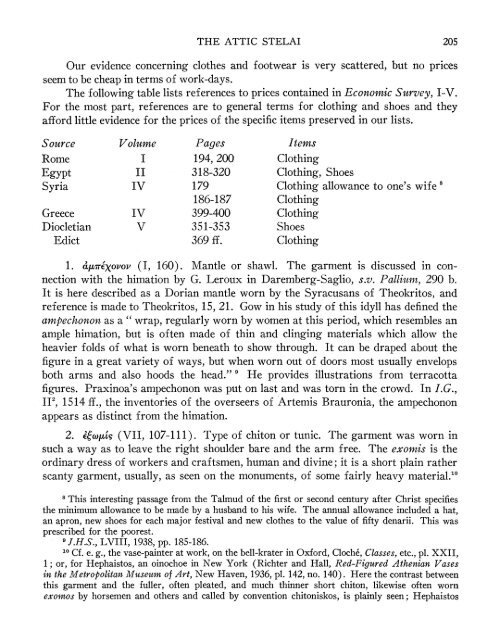the attic stelai - The American School of Classical Studies at Athens
the attic stelai - The American School of Classical Studies at Athens
the attic stelai - The American School of Classical Studies at Athens
Create successful ePaper yourself
Turn your PDF publications into a flip-book with our unique Google optimized e-Paper software.
THE ATTIC STELAI 205<br />
Our evidence concerning clo<strong>the</strong>s and footwear is very sc<strong>at</strong>tered, but no prices<br />
seem to be cheap in terms <strong>of</strong> work-days.<br />
<strong>The</strong> following table lists references to prices contained in Economic Survey, I-V.<br />
For <strong>the</strong> most part, references are to general terms for clothing and shoes and <strong>the</strong>y<br />
afford little evidence for <strong>the</strong> prices <strong>of</strong> <strong>the</strong> specific items preserved in our lists.<br />
Source Volume Pages Items<br />
Rome I 194, 200 Clothing<br />
Egypt II 318-320 Clothing, Shoes<br />
Syria IV 179 Clothing allowance to one's wife'<br />
186-187 Clothing<br />
Greece IV 399-400 Clothing<br />
Diocletian V 351-353 Shoes<br />
Edict 369 ff. Clothing<br />
1. adjTExovov (I, 160). Mantle or shawl. <strong>The</strong> garment is discussed in connection<br />
with <strong>the</strong> him<strong>at</strong>ion by G. Leroux in Daremberg-Saglio, s.v. Pallium, 290 b.<br />
It is here described as a Dorian mantle worn by <strong>the</strong> Syracusans <strong>of</strong> <strong>The</strong>okritos, and<br />
reference is made to <strong>The</strong>okritos, 15, 21. Gow in his study <strong>of</strong> this idyll has defined <strong>the</strong><br />
ampechonon as a " wrap, regularly worn by women <strong>at</strong> this period, which resembles an<br />
ample him<strong>at</strong>ion, but is <strong>of</strong>ten made <strong>of</strong> thin and clinging m<strong>at</strong>erials which allow <strong>the</strong><br />
heavier folds <strong>of</strong> wh<strong>at</strong> is worn bene<strong>at</strong>h to show through. It can be draped about <strong>the</strong><br />
figure in a gre<strong>at</strong> variety <strong>of</strong> ways, but when worn out <strong>of</strong> doors most usually envelops<br />
both arms and also hoods <strong>the</strong> head." 9 He provides illustr<strong>at</strong>ions from terracotta<br />
figures. Praxinoa's ampechonon was put on last and was torn in <strong>the</strong> crowd. In I.G.,<br />
JJ2, 1514 ff., <strong>the</strong> inventories <strong>of</strong> <strong>the</strong> overseers <strong>of</strong> Artemis Brauronia, <strong>the</strong> ampechonon<br />
appears as distinct from <strong>the</strong> him<strong>at</strong>ion.<br />
2. E4cwpiq (VII, 107-111). Type <strong>of</strong> chiton or tunic. <strong>The</strong> garment was worn in<br />
such a way as to leave <strong>the</strong> right shoulder bare and <strong>the</strong> arm free. <strong>The</strong> exomis is <strong>the</strong><br />
ordinary dress <strong>of</strong> workers and craftsmen, human and divine; it is a short plain ra<strong>the</strong>r<br />
scanty garment, usually, as seen on <strong>the</strong> monuments, <strong>of</strong> some fairly heavy m<strong>at</strong>erial.10<br />
8 This interesting passage from <strong>the</strong> Talmud <strong>of</strong> <strong>the</strong> first or second century after Christ specifies<br />
<strong>the</strong> minimum allowance to be made by a husband to his wife. <strong>The</strong> annual allowance included a h<strong>at</strong>,<br />
an apron, new shoes for each major festival and new clo<strong>the</strong>s to <strong>the</strong> value <strong>of</strong> fifty denarii. This was<br />
prescribed for <strong>the</strong> poorest.<br />
9 J.H.S., LVIII, 1938, pp. 185-186.<br />
10 Cf. e. g., <strong>the</strong> vase-painter <strong>at</strong> work, on <strong>the</strong> bell-kr<strong>at</strong>er in Oxford, Cloche, Classes, etc., pl. XXII,<br />
1; or, for Hephaistos, an oinochoe in New York (Richter and Hall, Red-Figured A<strong>the</strong>nian Vases<br />
in <strong>the</strong> Metropolitan Museum <strong>of</strong> Art, New Haven, 1936, pl. 142, no. 140). Here <strong>the</strong> contrast between<br />
this garment and <strong>the</strong> fuller, <strong>of</strong>ten ple<strong>at</strong>ed, and much thinner short chiton, likewise <strong>of</strong>ten worn<br />
exomos by horsemen and o<strong>the</strong>rs and called by convention chitoniskos, is plainly seen; Hephaistos
















